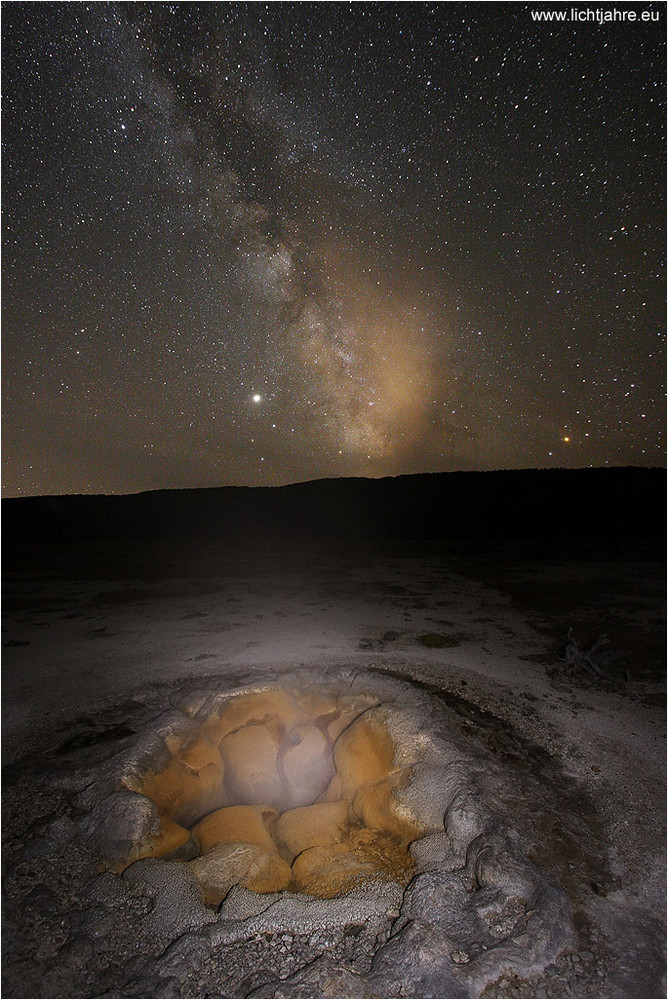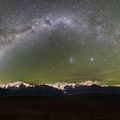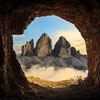Enigma of the Absolute
Dieser nächtliche Geysir stößt in fünfminütigen Intervallen kochendes Wasser und Gase aus. Angetrieben wird dieses hydrothermale System durch die Yellowstone Magmakammer in geringer Tiefe. Vulkanische Ausgasungen von Wasserdampf, Schwefelwasserstoff, Kohlendioxyd und Kohlenmonoxyd tragen seit jeher zur Zusammensetzung der Atmosphäre bei. Der heiße Dampf kondensiert schlagartig in der kalten Luft und diese Wolken reichen über das geneigte Gelände perspektivisch bis in den rechten Teil der Milchstrasse. Das hellste Objekt links im Bild ist Jupiter. Rechts der Milchstrasse steht das Sternbild Skorpion mit seinem Roten Riesen Antares, der 700 mal so groß wie unsere Sonne ist und nur 520 Lichtjahre entfernt steht.
August 2008
Canon 20D, Canon 10-22mm, f/3.5, statische und dynamische Aufnahme je 6 Min mit 10 sek neutraler Vordergrund Blitzausleuchtung, ISO 800, Stativ, Astro-Trac TT320 digitale Sternnachführung
Mehr Information unter
www.lichtjahre.eu
Where Geoscience Meets Art - Die Ästhetik der Geowissenschaft
Ein Projekt, das die Schönheit der Natur dokumentiert
und zum Verständnis der Geowissenschaften beiträgt
----------------------------------------------------------------------------------------
This nightly geyser is spouting boiling water and expels gases in five minute intervals driven by the Yellowstone magma chamber at shallow depth. Exhaled gases of water vapor, hydrogen sulfide, carbon dioxide and carbon monoxide from volcanic activity ever since contribute important constituents as trace gases to Earths atmosphere. The hot steam in the cold air causes instantaneous condensation that perspectively extends above the sloped terrain into the eastern branch of the Milky Way. The brightest object to the left is Jupiter. To the right of the Milky Way the Scorpio constellation is visible with its red star Antares, being 700 times larger than our sun at a distance of only 520 light years.
August 2008
Canon 20D, Canon EF-S 10-22mm, f/3.5, static and dynamic exposure of 6 min with 10 sec foreground neutral flash fire, ISO 800, tripod, AstroTrac TT320 digital astronomical mount
More information:
www.lichtjahre.eu
Where Geoscience Meets Art
A project that documents Nature's beauty
and enhances understanding of geosciences











Heidi Schneider 20. August 2011, 23:22
Ziel erfüllt: zeigt in herausragender Weise die Schönheit der NaturHier noch etwas zu den Grössenverhältnissen... [http://www.weripower.at/download/groessenverhaeltnisse.pdf]
Thomas Seiler 18. März 2009, 18:44
HAM-MER!!!Ern Jacoby 5. März 2009, 13:19
Alle Achtung, ganz schön aufwendig diese Aufnahme - das mach ich dir sobald nicht nach!LG Ern
Moonshroom 5. März 2009, 12:30
Wie auf einem anderen Planeten, sehr beeindruckend, klasse gemacht!VG --- Bernd
Jana Behr 5. März 2009, 11:41
Boah, das ist unbeschreiblich gut!LG Jana